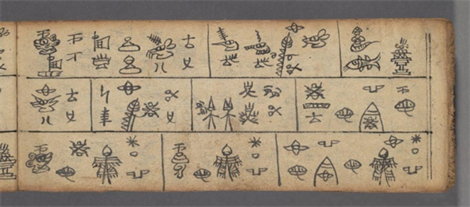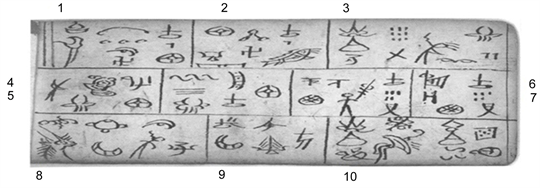Open Access Library Journal
Vol.06 No.02(2019), Article ID:90811,10 pages
10.4236/oalib.1105255
Study on the Associative Character of Dongba Script in Lijiang Area
Yin Zhou1,2
1Chinese History Postdoctoral Research Station, Southwest University, Chongqing, China
2Humanities College, Chongqing Jiaotong University, Chongqing, China

Copyright © 2019 by author(s) and Open Access Library Inc.
This work is licensed under the Creative Commons Attribution International License (CC BY 4.0).
http://creativecommons.org/licenses/by/4.0/



Received: November 3, 2018; Accepted: February 24, 2019; Published: February 27, 2019
ABSTRACT
Dongba script, which is in the early stages of writing, is an important pictograph, and the study of Dongba script helps to study the origin and development of writing. Through long-time researching on Dongba scripture in Lijiang area, we find that associative character in Dongba script is special. This article researches on the associative characters in Dongba script.
Subject Areas:
Linguistics, Sociology
Keywords:
Dongba Script, Associative Character, Lijiang Area

1. Introduction
Dongba script is used in religious activities by Naxi’s priest―Dongba. Because Dongba script is pictograph and is still in use, it is called the living fossil of human script, and there are nearly 1400 scripts in use. Lijiang, located in the northwest of Yunnan province, is the main settlement of Naxi. Lijiang Dongba culture is prosperous on the history, and there have been many famous Dongba, leaving a lot of beautifully decorated, elegant Dongba manuscript [1] (see Figure 1).
The American scholar Joseph Charles Francis Rock had been collecting Dongba manuscripts in Lijiang region and those Dongba manuscripts are now mainly kept in the Harvard―Yenching Institute [2] .
Pictograph is the most important feature of Dongba script and the most important script-making method. And when the Dongba has to express more
Figure 1. Dongba manuscript.
complicated meaning, they would use another method to create character, such as associative method, inactive method, and picot-phonetic method. Through long-time researching on Dongba scripture in Lijiang area, we find that associative character in Dongba script is special. This article researches on the associative characters in Dongba script.
The materials we use are from “An Annotated Collection of Naxi Dongba Manuscripts” [3] and “An Annotated Collection of Naxi Dongba Manuscripts” [4] . “An Annotated Collection of Naxi Dongba Manuscripts” is the biggest collection of Dongba manuscripts until now, covering almost all areas of Lijiang Dongba manuscripts. The materials quoted from the “An Annotated Collection of Naxi Dongba Manuscript” will be marked with the volume and the page, and “88.190” means that the material comes from volume 88, page 190. The materials quoted from the “Naxi Dongba manuscripts collected by Harvard―Yenching Institute” will be marked with the volume and the page, and “H4.250” means that the material comes from volume 4, page 250.
2. Interpretation Example of Dongba Scriptures in Lijiang Area
Dongba scriptures, which have been published with a translation, cannot be directly used as research materials in this paper. The published version includes the original content of Dongba scripture, international phonetic, corresponding translation, and Chinese translation, being called “four comparison version”. The four comparison version did not explain the origin and the evolution of every character.
The Dongba scripture and the Dongba character should be translated and analyzed character by character, which we call it “Zi Shi”. Through “Zi Shi”, we can make sure the original pronunciation and meaning, make sure the current pronunciation and meaning, and make sure the evolution of the characters. We will take the Dongba scripture “Awaken the Gods∙Sacrifice Food” for example, to show the “Zi Shi”.
The Dongba scripture “Awaken the Gods∙Sacrifice Food”, written by Donglu living in Qihe township, Lijiang city, is selected from “An Annotated Collection of Naxi Dongba Manuscripts”, Volume 85. See Figure 2.
Figure 2. “Awaken the Gods∙Sacrifice Food”.
ZiShi:
(1)
 [mɯ33] “sky”.
[mɯ33] “sky”.
 [kɯ21] “star”.
[kɯ21] “star”.
 [ha55] “night”.
[ha55] “night”.
 [ɯ33] “good, kind”.
[ɯ33] “good, kind”.
 [tʂhʅ33] “hang”, phonologically borrowed as demonstrative [tʂhʅ33] “this”.
[tʂhʅ33] “hang”, phonologically borrowed as demonstrative [tʂhʅ33] “this”.
 [dɯ33] “one”.
[dɯ33] “one”.
 [ȵi33] “sun”, meaning extended as “day time”.
[ȵi33] “sun”, meaning extended as “day time”.
(2)
 [ȵi55] “sun”, meaning extended as “time”.
[ȵi55] “sun”, meaning extended as “time”.
 [ʨər33] “wine glass”, graphic borrowed as position word [ʨər21] “up”.
[ʨər33] “wine glass”, graphic borrowed as position word [ʨər21] “up”.
 [dy21] “Ground”.
[dy21] “Ground”.
 [zy21] “star of zy”.
[zy21] “star of zy”.
 [ɯ33] “good, kind”.
[ɯ33] “good, kind”.
 [tʂhʅ33] “hand”, graphic borrowed as demonstrative [tʂhʅ33] “this”.
[tʂhʅ33] “hand”, graphic borrowed as demonstrative [tʂhʅ33] “this”.
 [dɯ33] “one”.
[dɯ33] “one”.
 [ȵi33] “fish”, graphic borrowedas [ȵi33] “day”.
[ȵi33] “fish”, graphic borrowedas [ȵi33] “day”.
(3)
 [py33bv21] Dongba,the priest of “naxi”.
[py33bv21] Dongba,the priest of “naxi”.







(4)






(5)






(6)







(7)






(8)







(9)





(10)







Translation:
(1) when Fairy’s night and Starlight is beautiful, (2) when the life in the daytime and three stars in the night is good, (3) “Ligu” Dongba will send ninety “Chu” ghost away, (4) will send “Dai” ghost, “Lao” ghost, (5) “Cloud” ghost and “Wind” ghost away. (6) “Ligu” Dongba lets soldier of “Pan” god, “Shan” god, (7) “Ga” god and “Wu” god, (8) have a rest for one night. (9) This morning, (10) “Ligu” Dongba shakes yellow board boll, awaking the sleeping god.
3. Associative Character and Its Types
Associative character is composed of several characters or composed of characters and symbols. The meaning of associative character is composed by all the parts, and every part plays an indispensable role in expressing the meaning.
3.1. Dividing from the Similarities and Differences of Components
3.1.1. Associative Character with the Same Texts
This type of associative character can be divided into two kinds: one kind is composed by the same components, and the same direction; the other kind is composed of the same components, but the opposite position.
A. 

The characters above are associative characters. The first character is composed by two trees, expressing the meaning of “forest”. The second also assemble two plants, expressing the meaning of “forest”. This character is composed by the same components, and the same direction.
B. Hand in hand 
The character is composed of two people. The two people each out their hands, expressing the meaning of “hand in hand”. This character is composed by the same components, but the opposite position.
C. Fight 

The first character is created by the shape of two people fighting with wooden sticks, expressing the meaning of “fight”; and the second character is more specific, 

This character is composed by the same components, but the opposite position.
3.1.2. Associative Character with the Different Texts
Associative character with the different texts, obviously, is composed by different texts.
A. Rain 

The character is composed of character 

B. Crop 

The first character is composed by 




C. Soldier 

The first character is composed of 



D. Host family 

The character is composed of 


E. Cast iron 

The combined character shows a man carries the tools to cast iron, expressing the meaning of “cast iron”.
F. Make plow 
The combined character shows a man carries the tools to make plow, expressing the meaning of “make plow”.
3.2. Dividing from the Method That the Component Similarities and Differences of Components
3.2.1. The Style of “Hui Xing”
Two or more characters combine together, forming a new character, and expressing a new meaning. The meaning of the new forming character is compose by every component, and all the components take part in expressing the meaning with the iroriginal meaning, so we can deduce the meaning when we see the new forming character.
A. Chop 


23.26
The translation of this scripture is “young people go fishing, and get ‘duo’ ghost of fish without fin; young people go chopping bamboo, and get ‘duo’ ghost of bamboo with two bifurcation”.
The new forming character 

26.119
The translation of this scripture is “chop three spruce trees, and make thousands of spears; chop three chestnuts, and make thousands of broadswords that wave like flying leaves”.
The new forming character 

59.66
The translation of the scripture is “When chopping trees, don’t chop white trees, and chop black trees belonging to ghost; don’t chop the white silk bridge, chop the ghost’s trunk”.
The first “chop” use picto-phonetic character





B. Drink 

The character looks like a picture that a man drinks from the cup with the straw, and there are drops around the straw, showing that the wine is flowing.
C. Burning incense 
The character is composed by 



3.2.2. The Style of “Xing Yi”
The style of “Xing Yi” means that the character is composed by two parts. Compared with the style of “Hui Xing”, the way of the components take part in expressing the meaning is different in the style of “Xing Yi”. One component composed with the original meaning, and one component composed with the extended meaning at least.
Summer 
The character is composed by two parts, the first part 





But the style of “Xing Yi” is less in Lijiang Dongba script.
3.3. Dividing from the Nature of the Components
According to the nature of the components, we can divide associative character into two styles: one style is combined by characters, and the other is combined by character and pictogram symbol.
3.3.1. Character + Character
A. Weaving 

The character is composed by 



B. Ride


The first character means ride the horse, and the second character means ride the elephant. The two character above is composed by 


C. Shoot 


Those three characters mean “shoot”, the first character is composed by the people, bow and the arrow. The second and the third composed by the bow and the arrow, expressing the meaning “shoot”.
D. Lean against 
The character is composed by 



3.3.2. Character + Pictogram Symbol
A. Open 

The character is composed by 




B. 

The character is composed by the 




4. Characteristics of Lijiang’s Associative Character
4.1. Large Quantity, and Great Majority Are Style of “Hui Xing”
There are many associative characters in Dongba characters, and the majority of which are “Hui Xing”. “Hui Xing” is the basic style of associative characters.
4.2. Change Shape of Character According to the Text
It is a very common phenomenon to change the shapes of character according to the text. For example, the word “chop”, now writes 



5. Conclusion
Dongba script is at an early stage of the development of the character and has important reference value for the formation and development of the character. The method of associative character is an important method of creating character in Dongba script, and it has two significances: for one hand, it helps to express the concept and word that the method of pictograph cannot express; for the other, the method of associative character reflects the psychology of the ancestors who create the character. Dongba scripture is the Memory of the World, and it is of great significance to carry out systematic research on Dongba script.
Sponsored
This article is sponsored by Chongqing Postdoctoral Special Fund Project (Item Number: Xm2017153), Chinese Postdoctoral Science Fund Project (Item Number: 2016M602621), and Chongqing Education Commission Social Science Fund Project (18SKGH054).
Conflicts of Interest
The author declares no conflicts of interest regarding the publication of this paper.
Cite this paper
Zhou, Y. (2019) Study on the Associative Character of Dongba Script in Lijiang Area. Open Access Library Journal, 6: e5255. https://doi.org/10.4236/oalib.1105255
References
- 1. Fang, G.Y. and He, Z.W. (2005) Word Spectrum of Naxi Pictograph. Yunnan Renming Press, Kunming, 42-44.
- 2. Li, L.C. (1984) The Mo-So Classic Collected in Library of Congress. In: Li, L.C., Ed., The Theses of Mo-So Study, Taiwan Palace Museum Press, Taiwan, 127-160.
- 3. The Institute of Domba Culture (1999) The Collected Works of Naxi Domba Manuscripts. Yunnan Renming Press, Kunming.
- 4. Institute of Ethnology and Anthropology, Chinese Academy of Social Sciences (2011) Naxi Dongba Manuscripts Collected by Harvard—Yenching Institute. China Social Sciences Press, Beijing.






